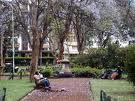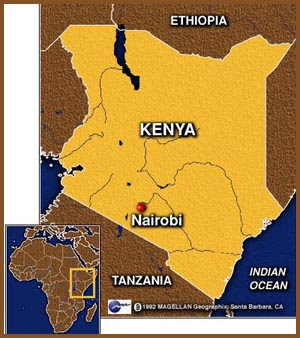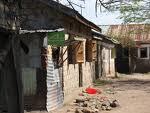:::::::::::::::::::::::::::::::::::::::::::::::::::::::::::::::::::::::::::::::::::::::::::::::::::::
Slum fires
(Swahili : moto (singular) mioto (plural))
***** Location: Kenya
***** Season: Topic
***** Category: Humanity
*****************************
Explanation
The urban slums of Kenya are highly prone to fires.
This is due to a cumulation of causes.
Each homestead has as its main focus the jiko, the fireplace or brazier, where food is cooked and heat is generated in the cold season. The jiko can be the traditional three stones, with firewood or maize cobs used as fuel. In the urban areas, it will more commonly be a brazier using charcoal, or a small metal cooker using kerosene oil.
Light is produced by hurricane lamps burning kerosene. Most homes keep a small supply of kerosene for their lamps and jiko.

Houses are small, and many combustible materials are kept within close range of any of these open fires. People, possibly with trailing clothes, move around the vicinity, and sometimes children play too near the fireplaces. During the cold season, nights are chilly, and there can be a tendency to leave fires to burn themselves out slowly while people are already falling asleep.
Ironing is done with charcoal irons, using live coals.
Many Kenyans are smokers, and careless handling of cigarettes can also cause fires.
Some small businesses use open fires -- maize roasters, fish fryers and mandazi bakers. These fires are normally well supervised and in any case extinguished as night falls.
Slum homes may also be threatened by external circumstances. These are fires starting in their neighbours' homes, fires due to sparking electricity cables, and (in one terrible incident in September 2011) a fire at the Kenya Pipeline in the Sinai section of Lunga Lunga slum. The huge oil pipeline, which ran through the slum, sprung a leak, and the slum dwellers tried to catch the spilling oil. It caught fire and exploded, killing and burning many. Some people jumped into the burning Ngong River to quench the flames, and many drowned there.
Text and photo © Isabelle Prondzynski
:::::::::::::::::::::::::::::::::::::::::::::::::::::::::::::::::::::::::::::::::::::::::::::::::::::
Some terrible pictures here of the Sinai fire (explosion at the Kenya Pipeline)
source : www.flickr.com
And a video of the scene :
source : http://www.youtube.com
:::::::::::::::::::::::::::::::::::::::::::::::::::::::::::::::::::::::::::::::::::::::::::::::::::::
Written in August 2012
About a month ago, fire broke out in one of the houses in the Tujisaidie community in Soweto (in the Kayole suburb of Nairobi), and everything that the family owned was destroyed. Fortunately, no one was injured and the fire did not spread to neighbouring plots.

The community's youth group, Tumaini, was at that time welcoming a group of British visitors. Abandoning their guests to respond to the call for help, the youth ran to the site of the fire and, together with the neighbours, worked hard to put it out. This involved carrying water over quite a distance, as the pipes were dry at this time. The visitors helped as best they could, carrying jerricans of water in a long chain from the Nursery School water tank, until the flames had been quenched.
For the next day, they had planned a programme of calls to several projects in the community. But the visitors discussed the matter overnight and decided that helping to rebuild the burnt house was much more important. And so, they each contributed whatever funds they could, so that building materials could be bought, and the rest of the day was spent putting up a new corrugated iron house.
The rest of the community also got together. Everyone who could, donated some clothes, some pots and pans, a blanket and other essential items, to give the affected family a new start. Slum families support each other... and each of them had probably been helped by others already, at some other time...
Isabelle Prondzynski
*****************************
Worldwide use
*****************************
Things found on the way
*****************************
HAIKU
as his fire crackles
there is laughter and chat --
maize roaster
last rays
of the red sunset --
maize roaster’s fire
evening cool --
the fish fryer’s fire
glows from afar
Isabelle Prondzynski
:::::::::::::::::::::::::::::::::::::::::::::::::::::::::::::::::::::::::::::::::::::::::::::::::::::
updates of fire
in Soweto on Facebook --
tears on my face
the fire --
Soweto goes dark
once again
still standing --
burnt electricity poles
telling the story
black smoke
engulfs the Soweto sunset --
a rush of helpers
water water
everyone calls --
flames and smoke
Antony Njoroge
:::::::::::::::::::::::::::::::::::::::::::::::::::::::::::::::::::::::::::::::::::::::::::::::::::::
Fire in Soweto, August 2012
fire outbreak --
a woman cries pleading
for quick help
rescue group --
the watching crowd
moves away
fire outbreak --
black smoke makes its way
to the atmosphere
~ Brian Mulando
singing a song
from a blackened Golden Bells --
smouldering remains
dancing smoke
from a burnt mattress --
village fire
~ James Bundi
On Saturday at dusk, after the fire tragedy that also destroyed a transformer and left a section of Soweto in darkness for three days, while we stood by watching the Kenya Power and Lighting Company staff fixing the transformer:
shooting star--
we mistake its bright streak
for power return
Patrick Wafula, August 22, 2012
:::::::::::::::::::::::::::::::::::::::::::::::::::::::::::::::::::::::::::::::::::::::::::::::::::::
thick smoke --
my eyes are drenched
with tears
she wails
on seeing burnt bodies --
Sinai inferno
oil floats on
sparkling sewage --
Ngong River
an injured boy
is lifted onto a stretcher --
rescue mission
Sinai heat --
flames bubbling in
the smokey sky
Sinai tragedy --
oil fumes linger
in the air
a pastor leads
the bereaved in prayer --
Sinai fire
Tom Mboya Hall --
a pile of burnt mabati
at the entrance
bereaved parade --
a photographer identifies
an impostor
~ Andrew Otinga
(on the Sinai Pipeline tragedy mentioned above)
xxxxxxxxxxxxxxxxxxxxxxxxxxxxx
fire tragedy --
a crying child asking
for her mother
Sinai fire --
displaced children
crying for food
Authors unknown
:::::::::::::::::::::::::::::::::::::::::::::::::::::::::::::::::::::::::::::::::::::::::::::::::::::
August cold --
a maize roaster pokes
his smouldering fire
Caleb Mutua
:::::::::::::::::::::::::::::::::::::::::::::::::::::::::::::::::::::::::::::::::::::::::::::::::::::
on a jam
dusty matatus on a stand still -
Nakumatt blaze
Nakumatt blaze was a great supermarket fire in 2009.
Siboko Yamame
. Matatu minibus .
*****************************
Related words
***** Jiko (brazier) and makaa (charcoal)
***** WKD : Fire (kaji)
kigo for all winter in Japan
[ . BACK to WORLDKIGO . TOP . ]
:::::::::::::::::::::::::::::::::::::::::::::::::::::::::::::::::::::::::::::::::::::::::::::::::::::
























